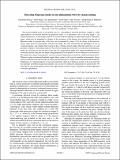| dc.contributor.author | Ben-Shach, Gilad | |
| dc.contributor.author | Haim, Arbel | |
| dc.contributor.author | Appelbaum, Ian | |
| dc.contributor.author | Oreg, Yuval | |
| dc.contributor.author | Yacoby, Amir | |
| dc.contributor.author | Halperin, Bertrand I. | |
| dc.date.accessioned | 2017-02-17T21:26:05Z | |
| dc.date.issued | 2015 | |
| dc.identifier.citation | Gilad Ben-Shach, Arbel Haim, Ian Appelbaum, Yuval Oreg, Amir Yacoby, and Bertrand I. Halperin. 2015. Detecting Majorana modes in one-dimensional wires by charge sensing. Phys. Rev. B 91, 04540. | en_US |
| dc.identifier.issn | 1098-0121 | en_US |
| dc.identifier.uri | http://nrs.harvard.edu/urn-3:HUL.InstRepos:30367412 | |
| dc.description.abstract | The electron number parity of the ground state of a semiconductor nanowire proximity coupled to a bulk superconductor can alternate between the quantized values ±1 if parameters such as the wire length L, the chemical potential μ, or the magnetic field B are varied inside the topological superconductor phase. The parity jumps, which may be interpreted as changes in the occupancy of the fermion state formed from the pair of Majorana modes at opposite ends of the wire, are accompanied by jumps δN in the charge of the nanowire, whose values decrease exponentially with the wire length. We study theoretically the dependence of δN on system parameters, and compare the locations in the μ−B plane of parity jumps when the nanowire is or is not proximity coupled to a bulk superconductor. We show that, despite the fact that the wave functions of the Majorana modes are localized near the two ends of the wire, the charge-density jumps have spatial distributions that are essentially uniform along the wire length, being proportional to the product of the two Majorana wave functions. We explain how charge measurements, say by an external single-electron transistor, could reveal these effects. Whereas existing experimental methods require direct contact to the wire for tunneling measurements, charge sensing avoids this issue and provides an orthogonal measurement to confirm recent experimental developments. Furthermore, by comparing density of states measurements which show Majorana features at the wire ends with the uniformly distributed charge measurements, one can rule out alternative explanations for earlier results. We shed light on a parameter regime for these wire-superconductor hybrid systems, and propose a related experiment to measure spin density. | en_US |
| dc.description.sponsorship | Physics | en_US |
| dc.language.iso | en_US | en_US |
| dc.publisher | American Physical Society (APS) | en_US |
| dc.relation.isversionof | doi:10.1103/PhysRevB.91.045403 | en_US |
| dash.license | LAA | |
| dc.title | Detecting Majorana modes in one-dimensional wires by charge sensing | en_US |
| dc.type | Journal Article | en_US |
| dc.description.version | Version of Record | en_US |
| dc.relation.journal | Phys. Rev. B | en_US |
| dash.depositing.author | Yacoby, Amir | |
| dc.date.available | 2017-02-17T21:26:05Z | |
| dc.identifier.doi | 10.1103/PhysRevB.91.045403 | * |
| dash.identifier.orcid | 0000-0003-1675-482X | en_US |
| dash.contributor.affiliated | Ben-Shach, Gilad | |
| dash.contributor.affiliated | Halperin, Bertrand | |
| dash.contributor.affiliated | Yacoby, Amir | |
| dc.identifier.orcid | 0000-0003-1675-482X | |


